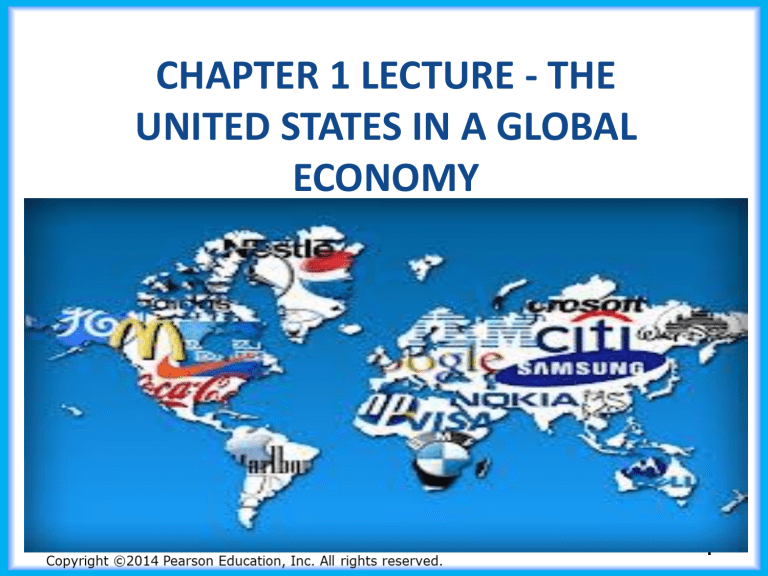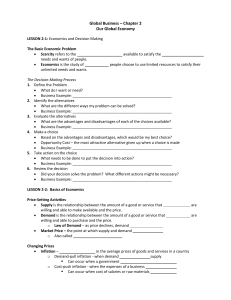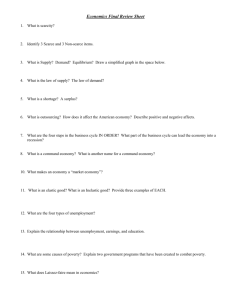
CHAPTER 1 LECTURE - THE
UNITED STATES IN A GLOBAL
ECONOMY
1
Learning Objectives
• Explain how economists measure international
economic integration.
• List the three types of evidence to support the
idea that trade supports economic growth.
• Discuss the differences in international
economic integration at the end of the
nineteenth century and the current era.
• Describe the major themes of international
economics.
2
International Economics as a Field
of Study in Economics
Question: What makes economic relations
among nation states different from economic
relations within a nation state?
Possible Answers:
• Each country identifies itself by a geographical
area over which it claims sovereignty.
•
• Each country has its own government and its
own sets of rules and regulations. The political
systems of most nation states are different.
3
Possible Answers
Activities or transactions leading to movements of people,
factors of production (i.e., labor, capital and raw materials),
manufactured goods and services across a county's borders are
often controlled or restricted and in some cases are prohibited.
Most nation states have their own monies (currencies) and
banking systems.
Despite the basic commonalties among all human beings,
people of different countries tend to have different cultures,
speak different languages, and have different tastes and
habits.
==>All of the above have restricting effects on economic
interactions among nation states.
4
What is International Economics About?
• International economics deals with economic
interactions that occur between independent
nations.
– The role of governments in regulating international
trade and investment is substantial.
– Analytically, international markets allow governments
to discriminate against a subgroup of companies.
– Governments also control the supply of currency.
• There are several issues that recur throughout the
study of international economics.
5
What is International Economics About?
• The Gains from Trade
– Many people are skeptical about importing goods that a
country could produce for itself.
– When countries sell goods to one another, all countries
benefit.
– Trade and income distribution
• International trade might hurt some groups within nations.
• Trade, technology, and wages of high and low-skilled workers.
• The Pattern of Trade (who sells what to whom?)
– Climate and resources determine the trade pattern of
several goods.
– In manufacturing and services the pattern of trade is more
subtle.
– There are two types of trade:
• Interindustry trade depends on differences across countries.
• Intraindustry trade depends on market size and occurs among
similar countries.
6
Interindustry and Intraindustry Trade
Further Explained
• Interindustry trade is a trade of products that belong to
different industries. For instance, the trade of
agricultural products produced in one country with
technological equipment produced in another country
can be classified to be an inter-industry trade. Countries
usually engage in inter-industry trade according to their
competitive advantages.
• Intraindustry trade, on the other hand, is a trade of
products that belong to the same industry. The term is
usually applied to international trade, where the same
types of goods or services are both imported and
exported.
7
What is International Economics About?
• How Much Trade?
– Many governments are trying to shield certain industries
from international competition.
– This has created the debate dealing with the costs and
benefits of protection relative to free trade.
• Advanced countries’ policies engage in industrial
targeting.
• Developing countries’ policies promote
industrialization:
– Import substitution versus export promotion
industrialization.
8
What is International Economics About?
• The Balance of Payments
– Some countries run large trade surpluses.
• For example, in 1998 both China and South Korea ran
trade surpluses of about $40 billion each.
– Is it good to run a trade surplus and bad to run a
trade deficit?
• Exchange Rate Determination
– The role of changing exchange rates is at the
center of international economics.
9
What is International Economics About?
• International Policy Coordination
– A fundamental problem in international economics is
how to produce an acceptable degree of harmony
among the international trade and monetary policies
of different countries without a world government
that tells countries what to do.
• The International Capital Market
– There are risks associated with international capital
markets:
• Currency depreciation
• National default
10
Globalisation
• Definition:
– An economic phenomenon?
– A social phenomenon?
– A cultural phenomenon?
• Globalization: the process of integration among
countries around the world with a vision of a single
market entity. The movement towards the
expansion of economic and social ties between
countries through the spread of corporate
institutions and the capitalist philosophy that leads
to the shrinking of the world in economic terms.
• Internationalization: the process of a business
crossing national and cultural borders.
11
Globalisation
http://wiki.ubc.ca/images/2/22/Globalisationmap.gif
Globalisation
could involve all
these things!
12
International Economics
– Is NOT about countries
– It IS about interactions among countries
Integration of Economies
• The increasing reliance of economies on each other
• The opportunities to be able to buy and sell in any
country in the world
• The opportunities for labour and capital to locate
anywhere in the world
• The growth of global markets in finance
13
International Economic Integration
• International integration of national economies has
brought many benefits to many nations
– Technological innovation
– Less expensive products
– Greater investments in scarce resource regions
• Today’s major economies are more integrated than
they’ve been at any time in history
– Instantaneous communications
– Modern transportation
– Relatively open trading systems
• This allows most goods to move across boundaries
without major obstacles and low relative costs
14
Elements of International Economic
Integration
There are four criteria or measures for judging the
degree of integration:
1.
2.
3.
4.
Trade flows
Capital flows
People flows
Similarity of prices in separate markets
Various Issues arise as a result. Can you think of
some?
15
Corporate Domination
•
•
•
•
•
•
Damage to the environment?
Exploitation of labour?
Monopoly power
Economic degradation
Non-renewable resources
Damage to cultures
Other Issues
• Accountability
of Global businesses?
• Increased gap between rich and poor fuels potential violent
reactions
• Ethical responsibility of business?
• Efforts to remove trade barriers
16
Who Trades the Most?
($ billions & % share, 2013)
Exporters
Value
Importers
Value
Share
Share
EU-28*
China
2307
2209
15.3
14.7
US
EU-28*
2329
2235
15.4
14.8
US
Japan
Korea, S.
1580
715
560
15047
10.5
4.8
3.7
100.0
China
Japan
Hng Kng
1950
833
622
15121
12.9
5.5
4.1
100.0
World
World
*EU external only
Source: WTO, International Trade Statistics, 2014, Table I.8
17
The Definition of an Open Economy
Trade patterns
• Openness
– Rough measure of the importance of international
trade in a nation’s economy
– Nation’s exports and imports as a percentage of its
Gross Domestic Product (GDP)
– Measure of openness or the trade to GDP ratio is
the ratio of trade to GDP
18
Importance of Trade for Countries?
(GDP in US$ b., Exports % of GDP
Country
USA
China
Japan
Germany
France
Brazil
UK
Italy
Russia
India
Canada
Australia
Spain
Mexico
South Korea
Indonesia
Turkey
Saudi Arabia
Argentina
South Africa
Level
13.49%
26.40%
14.73%
50.67%
28.28%
12.55%
29.84%
28.56%
28.37%
24.82%
30.08%
19.88%
31.56%
31.75%
53.92%
23.74%
25.65%
51.79%
14.27%
31.14%
Units
% of GDP
% of GDP
% of GDP
% of GDP
% of GDP
% of GDP
% of GDP
% of GDP
% of GDP
% of GDP
% of GDP
% of GDP
% of GDP
% of GDP
% of GDP
% of GDP
% of GDP
% of GDP
% of GDP
% of GDP
As Of
2013
2013
2012
2013
2013
2013
2013
2013
2013
2013
2013
2013
2013
2013
2013
2013
2013
2013
2013
2013
1Y Chg
-0.08%
-0.92%
-0.40%
-1.12%
0.20%
-0.03%
-0.41%
0.30%
-1.23%
0.82%
0.05%
-1.44%
1.24%
-0.90%
-2.42%
-0.55%
-0.65%
-2.63%
-1.53%
1.22%
~10Y Ago
9.63%
34.08%
11.87%
38.55%
25.91%
16.43%
24.36%
24.05%
34.42%
17.55%
37.46%
17.01%
25.18%
26.23%
38.30%
32.22%
23.55%
50.99%
21.50%
26.42%
~25Y Ago
8.91%
10.60%
9.76%
24.22%
21.48%
8.93%
22.59%
18.57%
21.90%
6.90%
25.12%
15.14%
16.68%
19.00%
28.53%
24.29%
16.20%
33.75%
13.06%
26.69%
Source: https://www.quandl.com/collections/economics/exports-as-share-of-gdp-by-country
http://data.un.org/Data.aspx?d=WDI&f=Indicator_Code%3ANE.EXP.GNFS.ZS
http://data.worldbank.org/indicator/NE.EXP.GNFS.ZS
19
Importance of Trade for Countries?
A Few More of Interest
Hong Kong
Korea, South
Korea, North (2009)
Burma
Syria
Israel
GDP
272
1198
28
59
65
273
Exports/GDP
168%
47%
7%
15%
6%
22%
Source: CIA World Fact Book
20
The Rise of the Emerging Economies
Lecture 1: Overview
21
A Little History - Waves of Globalization
• First Wave of Globalization: 1870-1914
• Decreases in tariff barriers
• Technological developments
– Declining transportation costs
• Shift from sail to steamships; railways
– Driven by European and American businesses and
individuals
© 2015 Cengage Learning. All Rights Reserved.
22
Waves of Globalization
First Wave of Globalization: 1870-1914
– Exports as a share of world income
• Nearly doubled to 8%
– Per capita incomes increased 1.3%
per year
• Previous 50 years: 0.5% per
year
– Nations that actively participated
in globalization
• Became the richest countries in
the world
– Brought to an end by World War I
© 2015 Cengage Learning. All Rights Reserved.
23
Waves of Globalization
• The Great Depression of the 1930s
– Governments practiced protectionism
• Raised tariffs on imports
– Tried to shift demand into domestic markets in order to
» Promote sales for domestic companies
» Promote jobs for domestic workers
– Exports as a share of national income
• Falls from 8% to 5%, undoing 80 years of technological
progress in transportation
© 2015 Cengage Learning. All Rights Reserved.
24
© 2015 Cengage Learning. All Rights Reserved.
25
Waves of Globalization
Second Wave of Globalization: 1945–1980
• Horrors of the retreat into nationalism renewed
incentive for globalization
• Falling transportation costs
• Decrease previously established trade barriers
• Trade liberalization – not uniform
– Which countries participated? Mainly
developed countries
– Which products were included? Manufactured
goods
© 2015 Cengage Learning. All Rights Reserved.
26
Waves of Globalization
• Trade liberalization discriminated
– Developed countries, manufactured goods
• Largely freed of barriers
– Greatly increased the exchange of manufactured goods
– Raised the incomes of developed countries
– Developing countries
• Exports from developing countries faced no barriers only
for agricultural/primary goods that were not produced in
developed countries
• Exports of manufactured goods - sizable barriers
© 2015 Cengage Learning. All Rights Reserved.
27
Waves of Globalization
• New kind of trade
– Rich country specialization in manufacturing niches
• Gained productivity through agglomeration economies
– Firms clustered together
– Some clusters produced the same product
– Others were connected by vertical linkages
• Agglomeration economies
– Benefits only those that are in the clusters
– No benefit for those that are left out
© 2015 Cengage Learning. All Rights Reserved.
28
Waves of Globalization
• Most developing countries
– Did not participate in the growth of global trade in
manufacturing and services
• Continuing trade barriers in developed countries
• Unfavorable investment climates
• Antitrade policies in developing countries
– Dependence on agricultural and natural-resource
products
• Developing countries as a group were being
left behind; World inequality
© 2015 Cengage Learning. All Rights Reserved.
29
Waves of Globalization
Latest Wave of Globalization, began in 1980
• Many developing countries participated led by
– China, India, and Brazil
– Entered the world markets for manufactured goods
• Other developing countries
– Increasingly marginalized in the world economy
– Decreasing incomes
– Increasing poverty
• Significant international capital movements
© 2015 Cengage Learning. All Rights Reserved.
30
Waves of Globalization
• Some developing countries
– Competitive advantage in labor-intensive manufacturing
• Bangladesh, Malaysia, Turkey, Mexico, Hungary,
Indonesia, Sri Lanka, Thailand, and the Philippines
• Tariff cuts and Lower barriers to foreign investment
• Technological progress in transportation and
communications
• Protectionist policies in developed countries
– More globalized - international trade, capital flows
– Less globalization - labor flows
• Foreign outsourcing
– Certain aspects of a product’s manufacture are performed in
more than one country
– What has been the effect?
31
© 2015 Cengage Learning. All Rights Reserved.
Waves of Globalization
• By the 2000s, foreign outsourcing
of white-collar work
– Information Age
• Digitization, Internet, and
high-speed data networks
around the world
– Sending upscale jobs offshore
• Accounting, chip design,
engineering, basic research,
and financial analysis
• Foreign outsourcing
– Reduce costs of a given service:
30 to 50%
© 2015 Cengage Learning. All Rights Reserved.
32
Capital and Labor Mobility
Two types of capital flows:
• flows of financial capital representing paper
assets such as stocks, bonds, currencies, and
bank accounts, and
• flows of capital representing physical assets
such as real estate, factories, and businesses foreign direct investment (FDI).
33
Capital and Labor Mobility
When comparing international capital flows today
to a century ago, two points to keep in mind:
1.Savings and investment are highly correlated
2.Technology improvements increase capital flows
Important quality differences in capital flows
today:
1. Many more financial instruments available
2. Role of foreign exchange transactions
3. Costs of foreign transactions has fallen
significantly (transaction costs)
34
The U.S. as an Open Economy
• Labor mobility in U.S. has not risen in past 100 years
– 1900, 14% of U.S. population: foreign born
– 1920s to 1960s – immigration sharply curtailed
• Foreign-born U.S. population: 6%
– 1960s, liberalized restrictions; By 2014
• 12% the U.S. population was foreign born
• Foreigners: 14% percent of the labor force
– Half from Latin America and one quarter Asians
Capital flows to the U.S.
• Foreign ownership of U.S. financial assets
– Risen since the 1960s
• 1970s, OPEC - investments in U.S. financial markets
• 1980s, major flows of investment funds to U.S.
• By late 1980s
– U.S. - consuming more than it produced
• Net borrower from the rest of the world
35
The U.S. as an Open Economy
International banking
• Average daily turnover in foreign-exchange market
– Today: almost $4 trillion
– 1986: $205 billion
• The trading day begins in Tokyo and Sydney and
moves around world in unbroken 24 hour cycle
• London - the largest center for foreign-exchange
trading
36
The U.S. as an Open Economy
• Commercial banking
– U.S. banks
• Worldwide branch networks, 1960s and 1970s
• Loans, payments, foreign-exchange trading
– Foreign banks
• Increased presence in U.S., 1980s and 1990s
• Today: 250 foreign banks
• Securities firms - globalized their operations
– By 1980s, U.S. government securities
• Traded on a 24-hour basis
37
Features of Contemporary International
Economic Relations
Deeper integration (based on extent of tariffs
and quotas)
Two trends the second half of 20th Century:
1.Lower trade barriers exposed most countries
with domestic policies as obstacles to
international trade
2.Labels such as “Made in China” or “Made in
the USA” are less and less meaningful
38
Features of Contemporary International
Economic Relations
Shallow integration
• reduction of tariffs and the elimination of
quotas
Deep integration
• negotiations over domestic policies that
impact international trade
• more contentious and harder to accomplish
39
Features of Contemporary International
Economic Relations
Multilateral organizations
International Monetary Fund (IMF)
World Bank
General Agreement on Tariffs and Trade (GATT)
United Nations (UN)
World Trade Organization (WTO) (grew out of the
GATT)
- Host of smaller organizations
-
40
Features of Contemporary International
Economic Relations
Regional trade agreements (RTAs)
– North American Free Trade Agreement (NAFTA)
– European Union (EU)
– Mercado Común del Sur (MERCOSUR)
– Asia Pacific Economic Cooperation (APEC)
– More than 330 have been recorded by the World
Trade Organization
41
Trade and Economic Growth
Economists remain convinced the benefits of trade
outweigh the costs pointing to three kinds of
evidence:
– Casual empirical evidence of historical experience
– Evidence based on economic models and deductive
reasoning
– Evidence from statistical comparisons of countries
While none of these is conclusive by itself,
together they provide evidence
42
Twelve Themes in
International Economics
1.
2.
3.
4.
5.
6.
The Gains from Trade and New Trade Theory
Wages, Jobs and Protection
Trade Deficits
Regional Trade Agreements
The Resolution of Trade Conflicts
The Role of International Institutions
43
Twelve Themes in International
Economics (cont.)
7. Exchange Rates and the Macroeconomy
8. Financial Crisis and Global Contagion
9. Capital Flows and the Debt of Developing
Countries
10. Latin America and the World Economy
11. Export-Led Growth in East Asia
12. The Integration of the BRICs into the World
Economy
44
Common Fallacies of International Trade
• “Trade is a zero-sum activity”
– False; Both partners gain from trade
• “Imports reduce employment and burden the economy,
while exports promote growth and employment”
– False; Source of this fallacy is the failure to consider the
link between imports and exports
• “Tariffs, quotas, and other import restrictions will save jobs
and promote a higher level of employment”
– False; failure to recognize that a reduction in imports does
not occur in isolation
• Free trade
– Increases competition, lowers prices
– Makes better products available to consumers
– Results in higher consumption
45
Backlash Against Globalization
Proponents of free trade and globalization say:
• Countries prosper
• New ideas and technology flow freely around
the world
• Productivity growth
• Increasing living standards
• Lower consumer prices
• Increased variety of goods and services
46
Backlash Against Globalization
Critics of free trade and globalization say:
• Benefits large corporations at the expense of average citizens
• Environmentalists
– Elitist trade organizations like WTO make undemocratic
decisions
• Undermine national sovereignty on environmental
regulation
• Unions
– Unfettered trade permits unfair competition
• Human rights activists
• World Bank and International Monetary Fund support
governments that:
– Allow sweatshops
– Pursue policies that bail out governmental officials at
the expense of local economies
47
http://www.slideshare.net/sallyleehall/globalization-3161053
48






